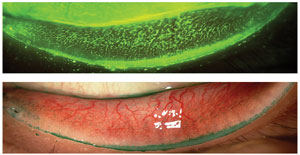 |
| Contact lens users may be more likely to have OSD effects due to the friction caused by blinking. Photo: Jalaiah Varikooty, Centre for Contact Lens Research. Click image to enlarge. |
During each blink, the undersurface of the eyelid interacts with the cornea and the bulbar conjunctiva. The presence of a contact lens can further add to the biomechanical friction on these surfaces, increasing the risk of ocular surface disorders such as lid wiper epitheliopathy (LWE), superior epithelial arcuate lesion, contact lens–induced limbal stem cell deficiency and superior limbic keratoconjunctivitis, all of which decrease a patient’s quality of life.
To estimate these frictional changes with and without a contact lens, researchers developed what’s called a finite element model of the eyelid wiper, eyeball and contact lens. Mechanical engineers often use finite element models to simulate physical phenomena and their effect on materials. The researchers transcribed the interactions of the 3D objects into a series of mathematical points that could then be analyzed. Biomechanical properties such as resilience against stress and displacement were calculated accordingly.
In the absence of contact lenses, the researchers found stress to be larger in the central 1.3mm of the cornea than in the peripheral cornea, which makes it susceptible to injury by the lid wiper. The force produced by the eyelid also displaced the cornea by 120µm posteriorly. The researchers suggested this large force on the lid wiper could be the reason for LWE seen in many patients with ocular dryness and discomfort.
With contact lenses in position, the study found that the eye’s ability to yield to stress was larger in the superior 1.3mm of the cornea than in the central cornea. The investigators attributed the formation of lens-induced superior epithelial arcuate lesion and limbal stem cell deficiency to the friction caused by the lid wiper on the superior cornea during a blink.
“With the contact lens in situ, during blink, the lid wiper pushes the lens against the ocular surface, which effectively moves the tears away, causing the surface to dry, thereby creating friction,” the researchers wrote in their paper. “Hence during blink, the contact lens slides over the high-pressure areas, i.e., the superior cornea and superior limbus. On long-term use, this can induce significant trauma to the ocular surface.”
Finite element analysis is a useful simulation tool that helps us understand the effects of blinking on a normal eye with and without contact lenses, they concluded. They proposed that ocular models could be used for other wider areas of research including simulation of surgery and trauma.
Ramasubramanian VS, Sundaram SM, Thomas R, et al. Finite element analysis of cornea and lid wiper during blink, with and without contact lens. Hindawi J Ophthalmol. May 17, 2022. [Epub ahead of print]. |


